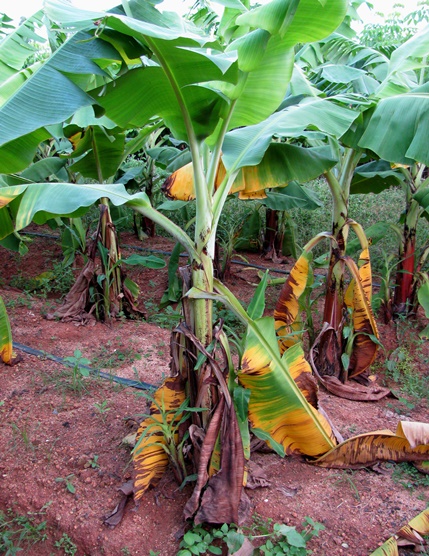Bananas (Musa genus) are one of the world's most valuable and popular primary agricultural commodities. However, the most prevalent naturally occurring bananas, that is, those of the Cavendish variety, are being severely decimated by Panama disease in Africa, Asia, and Australia. This deadly fungal disease, which was first noted in Panama in the late 1800s, is caused by a soilborne fungus, Fusarium oxysporum f. sp. cubense (Foc), and experts fear that new strains (pathotypes) of this Fusarium wilt disease will spread throughout the Americas, leading to the ultimate demise of the Cavendish bananas. However, genetically modified Cavendish banana trees are being field tested in Australia, and they have exhibited notable resistance to the disease-inducing fungus, providing hope to plant breeders and fruit crop growers. See also: Banana; Fruit; Fruit, tree; Fungal infections; Fungi; Genetic engineering; Genetically engineered plants; Horticultural crops; Panama disease of bananas

Prior to the 1950s, the most popular banana crop used for export purposes belonged to the Gros Michel cultivar (cultivated variety). However, that particular crop variety was wiped out by strains of the pathogenic fungus that causes Panama disease. Because the pathogen was resistant to fungicides and could not be controlled by chemical applications, the spread of Panama disease among Gros Michel bananas was swift, and banana growers worldwide were forced to plant different disease-resistant cultivars. The Cavendish variety rose to prominence across the world at this time and presently accounts for nearly all banana exports. Now, though, new strains of Fusarium oxysporum f. sp. cubense, specifically tropical race 4 (TR4), which originated in Southeast Asia, are threatening the Cavendish banana. See also: Pathogen; Plant pathology
To combat the spread of Panama disease, plant breeders and researchers are employing transgenic techniques that involve the transferring of certain genes. Specifically, investigators have cloned a number of resistance genes and have inserted them into Cavendish banana lines. Notably, in a three-year trial, complete resistance was observed in Cavendish bananas transformed with either RGA2 (a gene from a wild banana that is resistant to TR4) or Ced9 (a gene found in nematodes that provides resistance against various fungi). A few other transformed lines with alternative resistance genes also showed excellent results (in these cases, approximately 80% of the plants displayed no symptoms of disease). Therefore, if further progress can be made in scaling up the production of these genetically modified bananas, and if other technical difficulties associated with banana transformation can be overcome, genetic modification holds great promise for preserving the Cavendish banana. Still, many producers of bananas and other agricultural crops have noted that consumers have a strong aversion to the purchasing of known genetically modified products. It remains to be seen if the potential elimination of the Cavendish banana can convince consumers to accept a genetically modified version of one of the world's favorite foods. See also: Agricultural science (plant); Breeding (plant); Gene; Genetically modified crops; Genetically modified organism (GMO); Genetics





